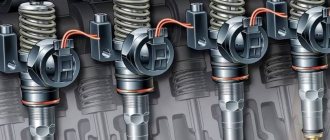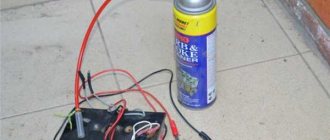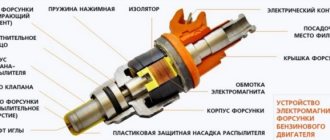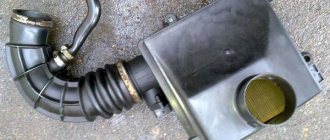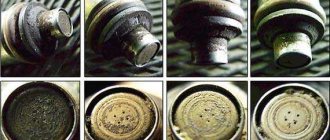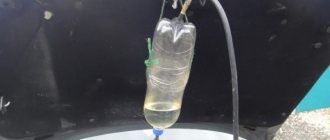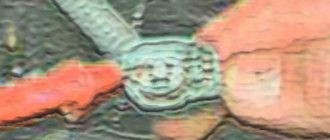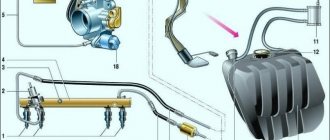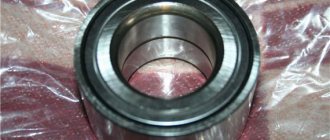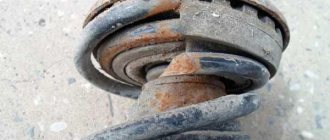Most modern cars are equipped with injection engines; the days of carburetor engines are gone forever. Injection power plants are more economical, environmentally friendly and productive, but at the same time they have a more complex design and injection system, consisting of a pressure regulator, injectors equipped with an electromagnetic valve, a fuel line, a fuel rail, intake valves and a number of other parts.
During operation, various fine particles and heavy fractions (sulfur, olefin, benzene and a number of others) are deposited on the designated parts, which come along with the fuel and can accumulate in the form of varnish and resinous deposits. In turn, this leads to contamination of the injectors, a change in the direction and shape of the spray pattern, and in some cases a complete cessation of fuel supply, even when using fuel filters that are capable of filtering out particles larger than 10-20 microns.
As a result, the formation of the air-fuel mixture is significantly deteriorated, the tightness of the pressure regulator valve is also compromised, and engine performance is reduced.
The deposition of these substances can interfere with the normal functioning of the working elements inside the nozzle, namely, it can disrupt the tightness of the valve, which is opened by an electromagnet controlled by the BC. In this case, when closed, they will allow gasoline to pass through due to constant pressure in the fuel system.
Signs of injector contamination.
When the injectors of an injection engine of any vehicle become dirty, characteristic signs of malfunction arise, which necessitates the need to clean the engine injectors. Among these signs we note:
- Difficulty starting the engine, especially as the outside temperature drops and the engine is cold;
- Unstable engine operation at idle;
- Perceptible dips when sharply or smoothly pressing the accelerator pedal;
- Loss of acceleration dynamics and power by the motor;
- Increased gasoline consumption;
- Increased toxicity of CO-CH exhaust gases;
- A several-fold increase in detonation when accelerating, which is a consequence of an increase in temperature directly in the combustion chamber and a depletion of the air-fuel mixture;
- Misfires (ignition);
- Periodic, characteristic popping sounds directly in the exhaust system;
- Premature failure of sensors, including the catalytic converter, spark plugs and oxygen sensor (lambda probe).
It should be noted that even if all the problems listed above are present during the operation of your machine, this does not mean that the cause is clogged injectors. These problems can arise for a large number of reasons - from the failure of any sensor (air meter, throttle sensor, lambda probe, IAC) or a drop in pressure in the fuel system (RDT, fuel filter, fuel pump), to spark plugs.
Nine Signs of a Bad Fuel Injector
It's possible that you rarely have problems with your fuel injectors. However, sometimes they become dirty, clogged, or fail completely and require replacement.
How do fuel injectors work?
The main function of the fuel injector is to supply the engine with fuel. The injector atomizes (injects) fuel into the engine cylinder through a nozzle so that the internal combustion process can begin. The fuel must be delivered at the right time, in the right quantity and at the right pressure, angle and spray pattern.
The engine control unit (ECU) is the central computer or "brains" of any vehicle, which controls many individual components, including the fuel injector. Using various sensors, the ECU ensures that the injector sprays fuel at the right time and in the right amount, and also creates the correct air-fuel mixture.
The vehicle's fuel pump supplies gasoline from the tank to the fuel injectors through fuel lines. When the ECU determines that the engine requires fuel, it transmits a message to the fuel injector solenoid, which then opens to allow pressurized fuel to be sprayed into the cylinder.
Nine Common Signs of Bad Fuel Injectors
If one or more fuel injectors fail, your vehicle's engine will not be able to function as intended. A faulty fuel injector will either prevent fuel from being sprayed into the engine or will disrupt the intervals at which fuel should be sprayed. In any case, your car will not work properly, and may not even move at all.
Below are nine signs of bad fuel injectors that you can recognize early on. Some of these are also symptoms of a clogged or dirty injector, so it's always worth trying a good injector cleaner on your fuel system first before spending money on replacing them.
You can pay a mechanic to clean your fuel injectors properly, or you can buy a kit to clean them and do it yourself. In any case, you should take care of this immediately to prevent serious damage to your car's engine.
No. 1. Rough idle or engine stalls
Because your vehicle is not getting enough fuel, or the fuel delivery is uneven, the idle speed drops below the optimal level, causing the engine to run rough or rough. If the RPM drops too low, the engine will stall and you will need to restart the car.
No. 2. Engine vibrations
A faulty fuel injector will cause the corresponding cylinder to fail to ignite. This means that while driving the engine will vibrate or sputter as it attempts to complete each cycle without fuel.
No. 3. Engine misfires
If a clogged injector prevents enough fuel from being sprayed into the cylinder, the engine will misfire while driving. There will be problems when accelerating or there will be a pause after pressing the gas pedal. In any case, you must take care of this soon, otherwise the engine will be susceptible to overheating or other problems that arise when the correct air-fuel mixture is not properly proportioned.
No. 4. The “Check Engine” light comes on.
The most obvious sign of a problem is when the check engine light illuminates on your dashboard. While this could mean a variety of problems, a faulty fuel injector could be one of them. Any time the injector delivers less fuel than needed (or in some cases more), engine efficiency decreases and can cause the above light to come on. Use an OBD2 scanner to confirm the problem.
No. 5. Fuel leak
If your car's fuel injector is truly broken or cracked due to damage or age, it will begin to leak gasoline. This means that the fuel will not be able to reach the injector, but will instead flow through the injector body. After checking the fuel injector, you will notice gasoline outside or at the nearest fuel rail. Often the leak is caused by a defective fuel injector seal that gets worse over time.
The main causes of injector contamination.
The main, but far from the only reason for clogging of injection engine nozzles, is undoubtedly the quality of the fuel. In Western Europe, almost no one cleans injectors; manufacturers only recommend changing them after 120-150 thousand kilometers.
But the injectors of cars that are operated in the territory of the former USSR have to be cleaned every 15 - 30 thousand kilometers. There is only one reason for the poor quality of fuel - the desire to receive excess profits from the sale of fuel and lubricants. As a result:
- Insufficient capacity for the production of A-92 and A-95 gasoline, but A-98 at domestic gas stations is in most cases a myth and a cunning marketing ploy - nothing more;
- Violation of fuel storage conditions. Often, the same tanks are used to store gasoline A-76, A-80, A-92, A-95, A-98, in which various tar deposits accumulate over the years of operation, dissolved by fuel with a higher octane number. As a result, tar deposits are washed into the tanks of our cars, leading to failure of the fuel system;
- The use of manganese-containing additives in the production of fuel, which increase anti-knock resistance. These are so-called anti-knock agents, which allow you to turn low-octane gasoline into high-octane gasoline with a slight movement of the hand. For example, an A-80 can “by magic” become an A-95, and there will be no detonation and its consequences as such. The additives, in turn, cause increased wear of the spark plugs and accelerated contamination of the fuel filter with fine brick-colored particles.
All these reasons lead to the need to replace spark plugs, clean the injector, and in some cases even overhaul the engine.
How to check injectors without removing them from the engine
The injector is an electromechanical valve that acts as an electric magnet. When voltage is applied to the injector winding, an electromagnetic field arises that can retract the core and needle of the shut-off device, while allowing a flow of fuel to the engine combustion chamber. An additional fuel filter is mounted on the input channel of the devices.
The injector is the final element of the fuel system, into which fuel enters under high pressure. The entire operation of an internal combustion engine directly depends on the performance of this component. When the pressure level drops when opening the injector, it opens earlier, which causes black smoke to form. If the pressure at the moment of opening increases, then it opens later and white smoke appears.
What functions does an injector perform in a car?
Absolutely all modern internal combustion engines, both diesel and gasoline, have a fuel injection mechanism. The nozzle in this system plays the role of a pump, supplying a very thin stream of fuel under high pressure and being one of the main elements of the injection system.
An engine injector is an electromagnetic valve that operates in accordance with a special program embedded in the engine control unit. This valve ensures a dosed supply of fuel to the cylinders. And today an injector means precisely an organized system of nozzles.
By purpose, these elements can be:
- for distributed injection;
- for central injection;
- for direct injection.
Fuel is supplied to each injector under a certain pressure due to the supply of electrical impulses from the control unit to the electromagnet. These pulses respectively open and close the needle valve at the right moments and thus regulate the flow of fuel through the nozzle channel into the cylinder. The longer the pulse lasts, the longer the valve will be open and the more fuel will flow into the injection element. The duration is regulated by the engine control unit. In addition to the duration of fuel supply, the nozzle mechanism allows you to create different shapes of the fuel torch and produce a jet at different angles. These variable parameters have a significant impact on the creation of the fuel mixture in the engine.
Not all car owners can immediately find an injection system in the engine. The location of the injectors depends on the type of injection used in a particular case:
- With a central injection scheme, 1-2 nozzles are located in the intake manifold near the throttle, completely replacing the carburetor.
- In a distributed scheme, each cylinder is equipped with a separate injector. In this case, the injector is located near the base of the intake manifold, where fuel is injected.
- In the direct scheme, the injector is placed on the cylinder walls in the upper part. Injection is carried out directly into the combustion chamber.
Thus, injection elements are an important component of a modern engine, the uninterrupted operation of which completely depends on these elements. Therefore, the injector needs periodic inspection and flushing.
Signs of injector failure
1. The operation of the engine starting elements slows down, which is especially pronounced in cold weather.
2. The occurrence of dips and some twitching of the car at the time of acceleration or change of transient modes.
3. Poor dynamics and reduction in engine power.
4. The amount of fuel consumed increases.
5. When idling, the car engine may run unevenly.
To avoid untimely car repairs, you should promptly check the performance of the injectors.
How to check injectors without removing them from the engine?
Checking the winding resistance level on the injectors
1. You can carry out an inspection by turning off the ignition and removing the negative terminal from the battery.
2. Using a thin screwdriver or an awl, you need to unclip the spring clip on the block.
3. Disconnect the connector from the injector.
4. Attach an ohmmeter to the injector terminals and measure the winding resistance.
5. If the resistance between the side and central pins of the connector is within 11–15 Ohms, then the injector is working properly. If the device shows more or less than required, it should be changed.
Checking the functionality of all injectors
1. Initially, you need to remove the fuel rail on which the injectors are installed.
2. Then you should connect the wire block to the ramp harness. If the “-” terminal was removed from the battery, then put it back on.
Checking the power supply to the injectors
Such a check must be carried out only when at least one of the injectors refuses to work when the ignition is turned on.
1. Disconnect the block with wires from the non-working part.
2. Then connect the two ends of the wires to the battery, and attach the other side to the contacts on the injector.
3. Turn on the car's ignition and check to see if fuel is leaking from the injector. If yes, then there is some kind of defect or malfunction in the electrical circuit.
Latest articles
How to understand what is wrong with the VAZ-2114 engine
The concept of “engine tripling” was invented by motorists themselves. It is associated with the design and operation of four-cylinder internal combustion engines. If one of the four cylinders failed, the internal combustion engine still continued to operate on the three remaining cylinders. But such a failure was distinguished by a characteristic sound, which was called “engine tripping” - functioning on only three cylinders. In this case, the fuel mixture in the idle cylinder will not burn as expected, but will accumulate.
If you do not respond to such a failure in the system in time, the fuel mixture will be diluted with oil, enter the crankcase with oil and dilute it thinner and thinner. In this case, the oil will lose its lubricating functions, which will lead to rapid wear of the rings, cylinder-piston group and other important parts of the car. A little later, the engine will have to be repaired not partially, but completely.
Similar failures occur in the VAZ-2114. They can be recognized by their characteristic features:
- The engine in idle mode manifests itself with periodic twitching, unevenly.
- When driving, the VAZ-2114 does not gain the required power.
- The car moves jerkily.
- If you press the gas pedal, failures in engine operation will be detected.
- An uneven exhaust comes out of the muffler, which is interrupted and accompanied by popping noises.
Against the background of these signs that the VAZ-2114 engine is failing, the driver may notice an increase in fuel consumption.
Possible reasons
It turns out that there are quite a lot of reasons for such a malfunction in the VAZ-2114 engine. They directly depend on the nature of the vehicle malfunction. So, most often the VAZ-2114 engine will triple due to:
- non-working candle;
- broken high-voltage wire;
- ignition coil failure;
- faulty control unit;
- presence of air leaks in the intake manifold;
- exhaust valve burnout;
- broken cylinder head gasket;
- broken compression rings on the piston;
- burning out of the piston itself;
- a broken piston bridge between the compression rings.
But since we are considering a VAZ-2114, the engine can also be damaged by faults in the injector - a fuel system with distributed injection.
How to troubleshoot injector problems?
To identify the causes of an injector malfunction, you need to go through half of the car. It takes a lot of time and effort. Special diagnostic equipment is required.
Advanced cases occur among drivers who do not monitor the condition of the car. Requires time and material costs to fix the problem.
Many drivers have an indecently dirty injection system. Lack of competent maintenance and low-quality fuel take their toll.
What to do if the engine on a VAZ-2114 is malfunctioning
To understand the causes of malfunctions in the VAZ-2114 engine, you need to know its configuration. He has:
- there are eight valves in the cylinder head;
- 1.6 liter internal combustion engine with 16 valves.
Experts advise that at the first signs of tripping, immediately check the functioning of the spark plugs. To do this, carry out the following steps:
- One by one, pull off the high-voltage wires from the cylinders.
- Pay attention to changes in engine operation:
- if there are no changes, the cylinder does not work.
The next step is to check the spark in the ignition system. This procedure is also simple:
- The first step is to remove the tip from the high-voltage wire.
- While the car engine is running, bring the wire from the cylinder head (ground) to the “break” position.
- Check for a spark between ground and wire:
- If there is no spark or the spark is too weak, then the ignition system is faulty.
But the following situation also happens: the spark is powerful, but malfunctions are still heard in the engine. This means that the time has come for the next step of testing - to measure compression in the cylinders, preferably in all of them at once. If the cylinder is operating correctly, there should be no difference in the pressure gauge readings (minor deviations are allowed). If the cylinder is faulty, there will be no or very weak compression.
A malfunction in the cylinder may be due to one of the following reasons:
- cylinder head gasket is broken;
- exhaust valve burnt out;
- piston rings burst;
- The piston itself burned out.
If you are unable to independently identify the reason that the VAZ-2114 engine is malfunctioning, you definitely need to do computer diagnostics. This can be done in two ways:
- On a special computer stand.
- Using a portable scanner (for example, ASKAN).
An experienced motorist himself will be able to figure out the malfunctions of the VAZ-2114 engine, but if he does not have sufficient experience, then it is best to contact qualified specialists at a service center for servicing cars of this model.
Checking the engine at idle
If you notice that the VAZ-2114 engine starts to stall at idle, then you need to check the following systems:
- Fuel supply system.
- Ignition system.
- Valve system.
In the first case, if the faults are in the fuel supply system, then the first step is to flush the fuel system, and then clean the injectors using ultrasound.
The second case involves problems with the ignition system. Therefore, perform the following actions:
- change spark plugs;
- check the functionality of the ignition coil;
- update the set of high-voltage wires.
In the third case, the valves are closely dealt with, that is, they should be adjusted so that they perform their functions properly. If this cannot be done, the old valves are simply replaced with new ones.
We fix the problem ourselves
To fix the problem yourself, you need to at least know where the spark plugs are. There are several solutions. The first is installing a new kit, of course, if you have one. It is advisable not to throw away the old ones, but simply put them in the garage. In order to remove the spark plugs, you will need a special spark plug wrench, which almost every motorist has. However, the method is not suitable for everyone, due to the lack of a new kit.
Now let’s look at a method that involves using old candles. The fact is that they are not spoiled, but simply filled with gasoline, but drying alone is also not enough. Therefore, we will need a furnace in which we can heat the candle to a high temperature and change color to red. This event is carried out in order to get rid of residual fuel and the carbon deposits that have actually formed. But here you need to remember that in this case, firstly, the ceramics of the candle will deteriorate, and secondly, polishing will be required before installation.
How to restore the performance of a VAZ-2114 engine: expert advice
Automotive repair experts recommend that motorists use several tips to restore the functioning of a VAZ-2114 engine that is tripping.
First tip: check and replace the electronic control unit.
Second tip: check and replace the oxygen sensor.
Third tip: check the functionality of the crankshaft position sensor. This can be done using the electronic control unit. This device will generate an error if the crankshaft position sensor is faulty. This means you will have to replace it with a new one.
Fourth tip: check and replace the ignition coil.
VAZ 2114 car injector system
The VAZ 2114 is equipped with an engine with a distributed fuel injection system (injector), and the stable operation of the engine of this car depends on the quality of gasoline. A low octane number of fuel leads to a drop in power and unstable operation of the power unit. As a result, any parts of the internal combustion engine (ICE) may fail. Mechanical impurities in fuel lead to clogging of fuel filters. the fuel pump is damaged. the injectors are clogged. You have to disassemble the fuel system (TS) and clean the injector. How the VAZ 2114 injector works, how to clean it and in what cases, how to remove and install the fuel rail, we will look at in this short article.
The VAZ 2115 injector is no different from the VAZ 2114, so when considering the device of the “fourteenth” model, we will also keep in mind the “15th”. The mechanical part of the injector includes:
- Intake manifold;
- Fuel rail (or rail, which is the same thing);
- Throttle assembly;
- Air filter with housing;
- Air pipe (injector corrugation);
- Injectors.
Gasoline injector device
Car enthusiasts who replace the carburetor with a distributed injection system in their “eights” and “nines” are puzzled by purchasing exactly these listed parts, not counting the electrical components.
The injectors on the VAZ 2114 are an electromagnetic device in which, when there is a pulse in the electrical component, a valve opens. and atomized fuel is injected under pressure into the internal combustion engine cylinder. Depending on the magnitude of the pulse, the valve opens to a greater or lesser extent, thereby dosing the flow.
Model 2114 can be equipped with fuel injectors from different manufacturers, and accordingly, the cost of the injectors may also differ. Manufacturers and cost (price range in the Russian Federation):
- GM (1300 - 1400 rub.),
- BOSCH (1000 - 1200 rub.),
- SIEMENS (800 - 1400 rubles).
The VAZ 2114 (2115) is equipped with engines of 1.5 and 1.6 liters (8 and 16 valves), therefore the performance of the injectors must be selected depending on the type of engine. If you make the wrong choice, fuel consumption may increase or the internal combustion engine may lose power. Which injectors are better to install on a VAZ 2114? Here you should focus on the part markings. For example, BOSCH 0 280 158 502 is only suitable for a 1.5 l 8-valve engine. It’s hard to say anything about the manufacturer; the quality of all products is approximately the same.
Symptoms of a problem
There are certain signs of clogged injector nozzles:
- Difficulties in engine operation, jerking;
- High gas consumption;
- Unstable engine operation at idle speed.
And, if the injectors are leaking, the internal combustion engine may not start at all. To improve engine operation, you should clean the injectors on the VAZ 2114.
Let's look at how to remove injectors on a VAZ 2114 (of course, everything is done with the engine not running, and it won’t hurt to disconnect the battery terminals). To do this we need a set of combination wrenches, a hexagon, screwdrivers and pliers:
- Relieve the pressure in the system. On the rear of the ramp there is a valve under the cap. We unscrew the cap and press the valve with a thin screwdriver or rod.
- Remove the air filter pipe;
- Disconnect the fuel lines (supply and return);
- Disconnect the electrical connectors from the injectors. The connectors are snap-on and easy to remove;
- We unscrew the two ramp mounting bolts (or a 10mm wrench or a hexagon):
- We dismantle the fuel rail.
Move the latch and take out the nozzle
The injector is removed from the ramp very simply - you need to move the locking washer to the side and pull out the injector using a little force.
Replacing injectors with the fuel rail removed is done simply - remove the old part, install the new one and secure it with a springy split washer. Then we install the fuel rail in place. Changing the nozzle is very simple.
Before cleaning, it won’t hurt to check the injectors on the VAZ 2114; it’s a good idea to first make sure they are not working. The check is carried out on a removed fuel rail; there is a special stand for this; many modern car repair shops are equipped with such stands.
You can check each individually removed injector by applying power to it and connecting a fuel tank to the inlet. When voltage is applied, the valve should operate and gasoline should spray out of the nozzle. But the test here is conditional; performance is almost impossible to determine.
Even more dubious is the idea with measuring cups, which is often described on resources on the Internet. Let's say all glasses are filled with the same amount of gasoline. How then did you determine the performance when simply cranking with the starter? After all, the engine operates at different speeds, and a faulty injector usually overflows gasoline depending on the voltage supplied to it. What if the electrical part is faulty?
Cleaning VAZ 2114 injectors is carried out mainly by removing parts, but you can try flushing the system with special fuel. The fuel supply hose is disconnected and a container with solvent is connected to the injector (a plastic “one and a half” can be used), pressure is created by an external electric pump. Remove the power connector from the “original” fuel pump. It is better if the injector cleaning (flushing) is carried out in a car service - doing such work with your own hands is quite troublesome, and it does not justify the money spent on it.
You can clean the injectors on a VAZ 2115 with your own hands with the fuel rail removed. A container with a special liquid for flushing carburetors is fitted to the fuel inlet of the injector, and power is supplied to the electrical connectors. When power is applied, the valve in the nozzle will work and it will spray this liquid. Do-it-yourself cleaning of VAZ 2114 injectors is also done.
The idea of cleaning injectors with your own hands is not always justified on VAZ models.
Expensive foreign cars make sense - the parts on them are expensive. And at VAZ, the cost of flushing and lost time will be more expensive than buying new spare parts. In addition, the results of cleaning are not guaranteed to be positive.
Malfunctions of the injector (nozzles) occur on both diesel and gasoline engines. In the design of the power supply system of an injection engine, the nozzle is an element that is responsible for injecting a sprayed portion of fuel into the combustion chamber under a certain pressure.
Precise dosing, tightness and timely operation of the injection nozzle ensure stable and proper operation of the engine in all operating modes. If the injector “flows” (passes excess fuel at a time when its supply is not required), the efficiency of fuel atomization decreases (the shape of the torch is disrupted) and other injector malfunctions occur, then the engine begins to smoke gray or black smoke, loses power, consumes a lot of fuel and etc.
Increased fuel consumption
If the injector springs are damaged, fuel will flow into the cylinders even when it is not needed, and will also flow in greater quantities than necessary. This will undoubtedly have a serious impact on the fuel consumption and smoke emissions of a diesel vehicle.
Pay attention to the signs described. By paying attention to the things described above in advance and visiting Diesel Service in a timely manner, you will save a large amount of your time and money.
Malfunctions of the injector (nozzles) occur on both diesel and gasoline engines. In the design of the power supply system of an injection engine, the nozzle is an element that is responsible for injecting a sprayed portion of fuel into the combustion chamber under a certain pressure.
Precise dosing, tightness and timely operation of the injection nozzle ensure stable and proper operation of the engine in all operating modes. If the injector “flows” (passes excess fuel at a time when its supply is not required), the efficiency of fuel atomization decreases (the shape of the torch is disrupted) and other injector malfunctions occur, then the engine begins to smoke gray or black smoke, loses power, consumes a lot of fuel and etc.
Read in this article
Which indicates possible problems with the injector
Let us immediately note that there can be many reasons for unstable engine operation, ranging from a clogged fuel filter, a broken fuel pump, a failed spark plug or a faulty coil, to loss of compression, problems with the timing belt, etc. Along with this, one of the main signs of injector malfunction is difficulty starting the engine, especially when cold, as well as gasoline or diesel consumption (depending on the engine type), which increases noticeably. It is also necessary to note the unstable operation of the internal combustion engine in idle mode, similar to the so-called “triple” of the engine.
When driving, it is possible that one or several symptoms may occur quite frequently:
- presence of jerks, very slow reactions when pressing the gas pedal;
- obvious failures and loss of dynamics when trying to accelerate sharply;
- the car may jerk while driving, when releasing the gas, and also after changing the load mode on the engine;
It must be added that such a malfunction must be corrected immediately, since problems with the injector negatively affect not only the service life of the engine and transmission, but also overall traffic safety. In a vehicle with faulty injectors, the driver may experience serious difficulties when overtaking, on steep hills, etc.
How to prevent candles from flooding
As noted above, on new cars the question does not arise: what to do if the spark plugs are flooded, since this does not happen. But you can get rid of this on any car, you just need to comply with a number of important requirements. Firstly, you need to use special motor oil that does not thicken at low temperatures, this allows you to start the engine without much effort and stress on the battery and starter.
Secondly, high-quality fuel will not allow your spark plug to burn out. What to do if good gasoline is difficult to find? That's another question. At the very least, you shouldn’t look for gas stations with minimal prices, as you simply risk running into diluted fuel. The injection nozzles should always be adjusted and cleaned, this will have a positive effect on the starting time.
Self-check of injectors
Let's start with the fact that automobile injectors are divided into several types, of which two types have found widespread use at different times: mechanical injectors and electromagnetic (electromechanical) injectors.
Electromagnetic injectors are based on a special valve that opens and closes the injector to supply fuel under the influence of a control pulse from the engine ECU. Mechanical injectors open as a result of increased fuel pressure in the injector. Let us add that modern cars often have electromagnetic devices installed.
To check the injectors with your own hands without removing them from the car, you can use several methods. The simplest and most affordable way to quickly check injection nozzles without removing them from the car is to analyze the noise emitted by the engine during operation.
Cleaning and flushing diesel injectors - the main differences
Cleaning diesel injectors is not a difficult task; the process repeats the cleaning of gasoline injectors; there are not many main differences, but they still exist and are quite significant.
The design of a diesel injector and the principle of its operation.
Firstly, signs of contamination of diesel injectors include loud engine operation; the same cannot be said about gasoline engines.
Additives and various cleaners for diesel injectors are sold in the same quantities as for gasoline engines.
You can also clean the injectors with ultrasound or using a special stand; you can make an improvised tank and connect it to the injection pump instead of the main fuel line.
How to check the power supply to the injectors
This check is carried out if the injectors themselves are working, but any of the injectors do not work when the ignition is turned on.
- for diagnostics, the connector is disconnected from the injector, after which two wires need to be connected to the battery;
- the other ends of the wires are attached to the injector contacts;
- then you need to turn on the ignition and record the presence or absence of fuel leakage;
- if fuel flows, then this sign indicates problems in the electrical circuit;
Another diagnostic technique is to check the injector using a multimeter. This method allows you to measure the resistance on the injectors without removing them from the engine.
- Before starting work, you need to find out what impedance (resistance) the injectors installed on a particular vehicle have. The fact is that there are injection nozzles with both high and low resistance.
- The next step is to turn off the ignition and also reset the negative terminal from the battery.
- Next you will need to disconnect the electrical connector on the injector. To do this, you need to use a screwdriver with a thin tip, with which you need to unclip a special clip located on the block.
- After disconnecting the connector, switch the multimeter to the desired operating mode for measuring resistance (ohmmeter), connect the contacts of the multimeter to the corresponding contacts of the injector to measure impedance.
- The resistance between the outer and central contacts of a high-impedance injector should be between 11-12 and 15-17 ohms. If the car uses low resistance injectors, then the indicator should be from 2 to 5 Ohms.
If obvious deviations from acceptable standards are noticed, then the injector must be removed from the engine for detailed diagnostics. It is also possible to replace the injector with a known good one, after which the engine performance is assessed.
Determining damage by hearing
Most experienced drivers can try to determine the operation of the injectors even by ear. Beginners are not recommended to use this method due to lack of experience.
To try to diagnose injectors by ear without removing them from the engine, you will ideally need a stethoscope or a small thin board. One side of the board must be pressed tightly against the TF being examined, and we place our ear on the other side.
When working properly, the nozzle does not emit any extraneous sounds, does not emit vibration, and generates rhythmic clicks extremely clearly. If uneven noises or knocking noises are heard, we can conclude that the nozzle is clogged. The degree of damage is determined by the volume and frequency of the unusual noise.
Motorists with extensive experience can do without a plate during analysis. If a malfunction exists, a muffled high-frequency sound will emanate from the engine area, very much like a squeak. If it is continuously heard while the engine is running, then the fuel injectors must be examined on a ramp or stand.
Comprehensive diagnostics of the operation of injectors on the ramp
For such a check, the fuel rail will need to be removed from the engine along with the injectors attached to it. After this, you need to connect all electrical contacts to the ramp and injectors if they were disconnected before removal. It is also necessary to return the negative terminal of the battery to its place.
- The ramp must be placed in the engine compartment so that a measuring container with a scale can be placed under each of the injectors.
- It is necessary to connect the fuel supply pipes to the ramp and additionally check the reliability of their fastening.
- The next step is to turn on the ignition, after which you need to crank the engine a little with the starter. This operation is best performed with an assistant.
- While an assistant rotates the engine, check the efficiency of all injectors. The fuel supply must be the same on all injectors.
- The final step will be to turn off the ignition and check the fuel level in the containers. The specified level must be equal in each container.
In addition to self-checking, you can use the injector diagnostic service at a car service center. This operation is performed on a special testing stand. Testing an injector on a bench allows you to accurately determine not only the efficiency of fuel supply, but also the shape of the torch during fuel spraying.
Washing without dismantling
There are different ways to clean an injector. At a car service center, I can offer you both flushing at a stand and a cheaper method, flushing using a special device that simulates the action of a gas pump. It connects to the car’s fuel rail and delivers cleaning fluid under pressure to the injectors; the engine runs only while flushing, after which the injectors can be considered clean. This method has several disadvantages; it is impossible to evaluate the quality of the spray and the degree of contamination of each nozzle. The method is budget-friendly and quite easy to implement with your own hands, instructions below.
I would also like to note the addition of cleaning additives to the fuel. Many manufacturers such as “Suprotek”, “Lavr”, “Wins” produce these washes and you can even buy them in supermarkets. I wouldn't call this method effective. The additive cleans deposits from the entire fuel line and after its use it is recommended to replace the fuel filter, since it will absorb all the dirt, but this liquid cannot dissolve tarry deposits in the injectors. If you haven’t cleaned the injectors for a long time, then this method will not help you. This is just prevention.
How to clean the injectors yourself without removing them from the engine
During the diagnostic process, a common cause of unstable engine operation is that the injection nozzles are clogged. There are several ways to clean injectors, among which mechanical, ultrasonic or cleaning using special chemical compounds can be used.
In some cases, pouring a special injector cleaner additive into the fuel tank is enough to normalize the operation of the entire system. It is also recommended to rev the engine to high speeds at certain intervals and accelerate the car to 110-130 km/h. on flat sections of the path. In this mode you need to drive 10-20 kilometers. Continuous operation of the injectors under load allows for so-called self-cleaning.
Cleaning the injector should be done as a preventive measure, and not after signs of malfunction appear. If the car is operated in city driving mode on fuel of questionable quality, then the interval of preventive measures should be reduced in relation to individual operating conditions.
When and why you need to remove fuel injectors from the engine. Removing injectors on gasoline and diesel engines: features of the dismantling process.
Cleaning a car injector without removing the injectors. Methods for cleaning injectors with removal on a cavitation stand. Ultrasonic and hydrodynamic cavitation.
Malfunctions of diesel injectors, checking and self-identification of problems. Cleaning diesel engine injector nozzles, regulating injection pressure.
Common diesel engine malfunctions and diagnostics of units of this type. Checking the fuel system of a diesel engine, useful tips.
Operating principle and distinctive features of gas injectors. Basic parameters when choosing nozzles for gas equipment 4. Which gas injectors are best to buy.
Features of operation and causes of malfunctions of diesel injectors. How to independently remove, troubleshoot, disassemble and repair diesel engine injectors.
Why, if the injector is pouring into the cylinder of a diesel engine, it is better to contact a service station
The modern injection element in a diesel engine is a very precise mechanism capable of operating at elevated temperatures with fuel of the appropriate quality. And one of the problems that diesel owners face is that the injectors begin to leak into the cylinders. When contacting a car service center with this problem, people often cannot clearly justify their confidence that it is the injector that is faulty. After all, without special equipment, it is almost impossible to determine that the injector is pouring into the cylinder. And external symptoms of injector malfunctions are often indistinguishable from signs of problems in the fuel system of a diesel engine.
Most modern diesel cars are equipped with Common Rail fuel systems from Bosch, Delphi or Denso. The components of these systems are highly sensitive to the quality of the diesel fuel used. Even a small proportion of mechanical impurities causes the injector to pour into the cylinder. Signs of a diesel engine malfunction (namely the injection system) will coincide with those described earlier. The source of problems is jammed or failed parts, as well as an increase in the diameter of the injector nozzle. At the same time, the engine suddenly begins to “trouble”, and black smoke pours out of the exhaust pipe. If the injector is pouring heavily into the cylinder and does not atomize fuel, this can lead to a more serious problem - melting of the pistons.
As already mentioned, when the injector pours into the cylinder, the pressure in the system drops below the minimum allowable. The solution to the problem depends on two points. In the first case, the injector pours in the opposite direction, in the second case it pours into the cylinder. Correctly identifying the true cause of a diesel fuel system malfunction can only be done through diagnostics at a special stand. Based on the identified problem, the issue of repairing the nozzle or replacing it completely will be decided.
It is not recommended to fix the problem with a diesel injector pouring into the cylinder yourself. The fact is that during the repair process the nozzle is completely disassembled and during reassembly it is necessary to strictly observe the regulated dimensions and tightening torques. Deviation of at least one parameter can lead to imbalance in the operation of the injector, as a result of which the pistons can burn out. If the injector flows “into the return” and not into the cylinder, it is tested on a bench. The tests consist of determining the amount of fuel poured in the opposite direction over a certain time interval for each injection element. The obtained data is checked against the manufacturer’s passport values.
